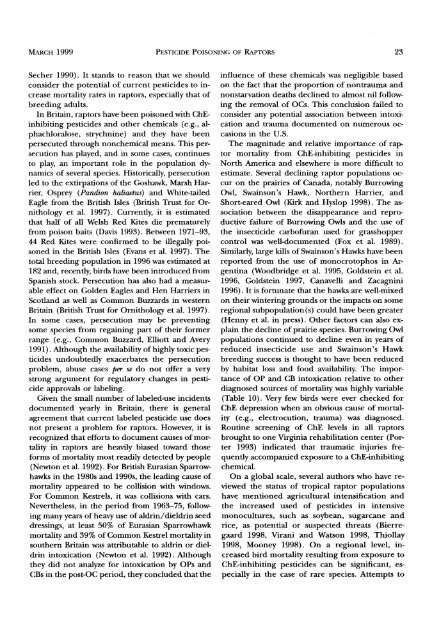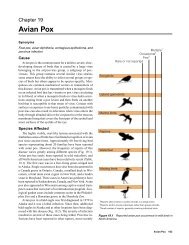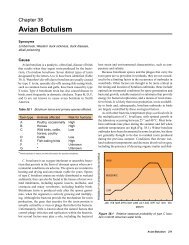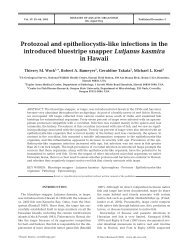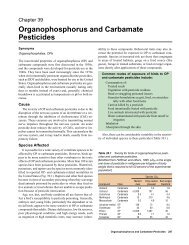poisoning of raptors with organophosphorus and carbamate ...
poisoning of raptors with organophosphorus and carbamate ...
poisoning of raptors with organophosphorus and carbamate ...
Create successful ePaper yourself
Turn your PDF publications into a flip-book with our unique Google optimized e-Paper software.
1VIARCH 1999 PESTICIDE POISONING OF RAPTORS 23<br />
Secher 1990). It st<strong>and</strong>s to reason that we should<br />
consider the potential <strong>of</strong> current pesticides to increase<br />
mortality rates in <strong>raptors</strong>, especially that <strong>of</strong><br />
breeding adults.<br />
In Britain, <strong>raptors</strong> have been poisoned <strong>with</strong> ChEinhibiting<br />
pesticides <strong>and</strong> other chemicals (e.g., alphachloralose,<br />
strychnine) <strong>and</strong> they have been<br />
persecuted through nonchemical means. This persecution<br />
has played, <strong>and</strong> in some cases, continues<br />
to play, an important role in the population dynamics<br />
<strong>of</strong> several species. Historically, persecution<br />
led to the extirpations <strong>of</strong> the Goshawk, Marsh Harrier,<br />
Osprey (P<strong>and</strong>ion haliaetus) <strong>and</strong> White-tailed<br />
Eagle from the British Isles (British Trust for Ornithology<br />
et al. 1997). Currently, it is estimated<br />
that half <strong>of</strong> all Welsh Red Kites die prematurely<br />
from poison baits (Davis 1993). Between 1971-93,<br />
44 Red Kites were confirmed to be illegally poisoned<br />
in the British Isles (Evans et al. 1997). The<br />
total breeding population in 1996 was estimated at<br />
182 <strong>and</strong>, recently, birds have been introduced from<br />
Spanish stock. Persecution has also had a measurable<br />
effect on Golden Eagles <strong>and</strong> Hen Harriers in<br />
Scotl<strong>and</strong> as well as Common Buzzards in western<br />
Britain (British Trust for Ornithology et al. 1997).<br />
In some cases, persecution may be preventing<br />
some species from regaining part <strong>of</strong> their former<br />
range (e.g., Common Buzzard, Elliott <strong>and</strong> Avery<br />
1991). Although the availability <strong>of</strong> highly toxic pesticides<br />
undoubtedly exacerbates the persecution<br />
problem, abuse cases per se do not <strong>of</strong>fer a very<br />
strong argument for regulatory changes in pesticide<br />
approvals or labeling.<br />
Given the small number <strong>of</strong> labeled-use incidents<br />
documented yearly in Britain, there is general<br />
agreement that current labeled pesticide use does<br />
not present a problem for <strong>raptors</strong>. However, it is<br />
recognized that efforts to document causes <strong>of</strong> mortality<br />
in <strong>raptors</strong> are heavily biased toward those<br />
forms <strong>of</strong> mortality most readily detected by people<br />
(Newton et al. 1992). For British Eurasian Sparrowhawks<br />
in the 1980s <strong>and</strong> 1990s, the leading cause <strong>of</strong><br />
mortality appeared to be collision <strong>with</strong> windows.<br />
For Common Kestrels, it was collisions <strong>with</strong> cars.<br />
Nevertheless, in the period from 1963-75, follow-<br />
ing many years <strong>of</strong> heavy use <strong>of</strong> aldrin/dieldrin seed<br />
dressings, at least 50% <strong>of</strong> Eurasian Sparrowhawk<br />
mortality <strong>and</strong> 39% <strong>of</strong> Common Kestrel mortality in<br />
southern Britain was attributable to aldrin or diel-<br />
drin intoxication (Newton et al. 1992). Although<br />
they did not analyze for intoxication by OPs <strong>and</strong><br />
CBs in the post-OC period, they concluded that the<br />
influence <strong>of</strong> these chemicals was negligible based<br />
on the fact that the proportion <strong>of</strong> nontrauma <strong>and</strong><br />
nonstarvation deaths declined to almost nil follow-<br />
ing the removal <strong>of</strong> OCs. This conclusion failed to<br />
consider any potential association between intoxication<br />
<strong>and</strong> trauma documented on numerous oc-<br />
casions<br />
in the U.S.<br />
The magnitude <strong>and</strong> relative importance <strong>of</strong> raptor<br />
mortality from ChE-inhibiting pesticides in<br />
North America <strong>and</strong> elsewhere is more difficult to<br />
estimate. Several declining raptor populations occur<br />
on the prairies <strong>of</strong> Canada, notably Burrowing<br />
Owl, Swainson's Hawk, Northern Harrier, <strong>and</strong><br />
Short-eared Owl (Kirk <strong>and</strong> Hyslop 1998). The association<br />
between the disappearance <strong>and</strong> reproductive<br />
failure <strong>of</strong> Burrowing Owls <strong>and</strong> the use <strong>of</strong><br />
the insecticide carb<strong>of</strong>uran used for grasshopper<br />
control was well-documented (Fox et al. 1989).<br />
Similarly, large kills <strong>of</strong> Swainson's Hawks have been<br />
reported from the use <strong>of</strong> monocrotophos in Argentina<br />
(Woodbridge et al. 1995, Goldstein et al.<br />
1996, Goldstein 1997, Canavelli <strong>and</strong> Zacagnini<br />
1996). It is fortunate that the hawks are well-mixed<br />
on their wintering grounds or the impacts on some<br />
regional subpopulation (s) could have been greater<br />
(Henny et al. in press). Other factors can also explain<br />
the decline <strong>of</strong> prairie species. Burrowing Owl<br />
populations continued to decline even in years <strong>of</strong><br />
reduced insecticide use <strong>and</strong> Swainson's Hawk<br />
breeding success is thought to have been reduced<br />
by habitat loss <strong>and</strong> food availability. The importance<br />
<strong>of</strong> OP <strong>and</strong> CB intoxication relative to other<br />
diagnosed sources <strong>of</strong> mortality was highly variable<br />
(Table 10). Very few birds were ever checked for<br />
ChE depression when an obvious cause <strong>of</strong> mortality<br />
(e.g., electrocution, trauma) was diagnosed.<br />
Routine screening <strong>of</strong> ChE levels in all <strong>raptors</strong><br />
brought to one Virginia rehabilitation center (Porter<br />
1993) indicated that traumatic injuries fre-<br />
quently accompanied exposure to a ChE-inhibiting<br />
chemical.<br />
On a global scale, several authors who have reviewed<br />
the status <strong>of</strong> tropical raptor populations<br />
have mentioned agricultural intensification <strong>and</strong><br />
the increased used <strong>of</strong> pesticides in intensive<br />
monocultures, such as soybean, sugarcane <strong>and</strong><br />
rice, as potential or suspected threats (Bierregaard<br />
1998, Virani <strong>and</strong> Watson 1998, Thiollay<br />
1998, Mooney 1998). On a regional level, increased<br />
bird mortality resulting from exposure to<br />
ChE-inhibiting pesticides can be significant, especially<br />
in the case <strong>of</strong> rare species. Attempts to


